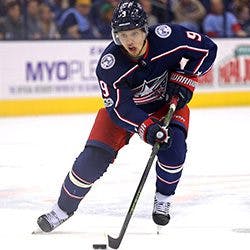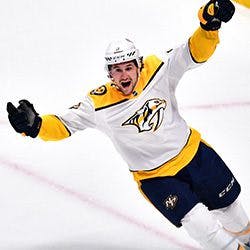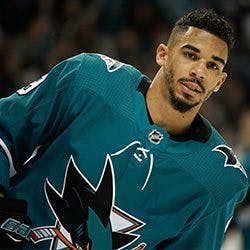Ranking Fantasy Hockey Left Wingers By Tiers (1-5)


These tier posts breakdown our positional rankings to help you better understand who you should be targeting in your fantasy draft and when you should be going after them. Here are our top left wingers for the 2018-19 season, starting with tiers 1-5. You can find the rest of our positional tiers here:
Tier 1
Alex Ovechkin (WSH)
Assuming there’s no ill effects from his (well-deserved) summer long bender, Ovechkin will once again be the best left winger available on draft day. Ovie buried 49 goals and added 38 assists last season on route to his seventh Rocket Richard Trophy and his first Stanley Cup. He’s entering his age 33 season and remains as reliable as they come. Remarkably, the Russian superstar has missed just 29 regular season games across the entirety of his 13-year career and has led the NHL in shots in 11 of those 13 years. He’s the best bet league-wide to hit 50 goals this year and is the only left winger deserving of a top 3 pick.
Tier 2
Brad Marchand (BOS), Jamie Benn (DAL), Artemi Panarin (CBJ), Taylor Hall (NJD), Johnny Gaudreau (CGY), Claude Giroux (PHI)

Benn bounced back last season with 36 goals and 43 assists after a ‘disappointing’ 69-point campaign in 2016-17. Much of his struggles in 2016 could be tied to a lack of shooting, dropping to 201 from 247 the year before, so it was encouraging to see Benn back over 240 shots last season. His durability and consistency are exactly the qualities you want out of a late first-round pick.
Panarin proved last season to be a whole lot more than Patrick Kane’s sidepiece, putting up 82 points in his first season with the Blue Jackets. He was able to log 55 assists (41 at even strength) despite suffering from an 8.5% on ice shooting percentage, a testament to his elite playmaking ability. His shot rates have gone up in each of his first three seasons of the league; that trend continuing combined with some better fortune could be enough to get him to 90 points this year.
Hall exploded for 39 goals and 54 assists last year, earning his first Hart Trophy. His personal and on ice shooting percentages were both well-above his career averages, meaning a repeat 90-point performance is unlikely. Some of that regression could be mitigated by the continued improvement of his young linemate, Nico Hischier, but Hall should have a floor of about 70 points regardless.
Gaudreau is coming off an 84-point season and will no doubt be the pillar of the Flames’ offense again this year. The biggest knock on Johnny Hockey is he doesn’t score enough goals, having only topped 25 goals once in his career. He took a step towards improving that last year with a career high 227 shots, but in the meantime his gargantuan assist totals are enough to keep him firmly rooted in our second tier.
Coming off the most productive season of his career, Giroux is the poster boy for regression heading into the 2017-18 season. His 17.6% shooting percentage was 6 points higher than his career average and was the driving force behind him topping 30 goals for the first time in his career. His 12.0% on ice shooting percentage was also well-above his career average, which helped him pile up a league-high 68 assists, with an astounding 41 coming at even strength. Giroux would be lucky to break 80 points again this season, let alone 100, but his elite playmaking ability is enough to keep him in our second tier.
Tier 3
Filip Forsberg (NSH), Clayton Keller (ARZ), Nikolaj Ehlers (WPG), Jonathan Marchessault (VGK)

Ehlers is coming off a second consecutive 60-point season despite playing only 16 minutes a night and spending most of the year on the Jets’ second powerplay unit. Though he’s ready to take on a larger role, his usage improving is not a given considering Winnipeg’s depth up front. Still, the possibility of an extra 2 or 3 minutes a night for the still improving 22-year-old gives him some serious upside. Out of all the Golden Knights’ who experienced a breakthrough last season, Marchessault’s seems to be the most genuine. His shot total ballooned from 193 to 268 last year, and his CF% hovered around 55% all season long. His usage still has room to grow as well (ATOI of 17:30 last season), suggesting an encore performance this year is well within Marchessault’s reach.
Tier 4
Ilya Kovalchuk (LAK), Rickard Rakell (ANA), Jonathan Huberdeau (FLA), Max Pacioretty (MTL), James van Reimsdyk (PHI), Jaden Schwartz (STL)

Huberdeau made some serious strides in his game last season, posting career highs in goals (27), assists (42), and shots (204). He finally reached the potential that made him a third-overall pick in 2011, and proved he could be a goal-scoring threat as well as an elite playmaker. The addition of Mike Hoffman to the Panthers’ top-six should only bolster Huberdeau’s production. After four straight seasons with at least 30 goals, Pacioretty could only muster 17 in 64 games last year. He showed signs of bouncing back from a dreadful start before the injuries set in, and the drop in goals can in large part be blamed on his lowly 8.0% shooting percentage. While his supporting cast in Montreal is weak right now, his expiring contract means he could very well end up on a contending team by the trade deadline. His average draft position of 112 in Yahoo! standard leagues makes him one of our top sleeper targets heading into the season.
Just exactly how large of a role JVR will get in his return to Philadelphia is unclear, but he’s proven that all he needs is powerplay time and some cushy 5v5 matchups to be productive. JVR scored a career-high 36 goals last season (11 on the powerplay) despite playing under 15 minutes a night. He’ll slot comfortably into the Flyers’ top-six and adds to what is already a strong first powerplay unit. The lack of assists is the only thing keeping JVR from going higher up our draft board. Registering 59 points in 62 games, Schwartz would have been on pace for a career year had he stayed healthy. He doesn’t shoot nearly as much as the guys ranked above him, but his high career shooting percentage and consistent assist totals are enough to justify fitting him into our fourth tier.
Tier 5
Mike Hoffman (FLA), Evander Kane (SJS), Gabriel Landeskog (COL), Kyle Connor (WPG)

It’s hard to forget about Landeskog’s terrible 2016-17 season in which he put up a mere 18 goals and 15 assists, but the Avs’ captain certainly did his best to make us do just that last season. The 25-year-old took full advantage of being tied to the waist of Nathan Mackinnon and Mikko Rantanen, registering 25 goals and 37 assists. Landeskog is definitely the weakest link on the Avs’ top line, but as long as his linemates are flirting with a point per game pace there’s no reason to think he won’t hit 60 points again. Connor registered 31 goals and 26 assists in his first full season, spending roughly 75% of his even strength ice time on the top line alongside Blake Wheeler. He should slot into the same role again this season and could potentially mitigate the expected regression of his 16.1% shooting percentage if he’s able to improve on his shot total of 192.